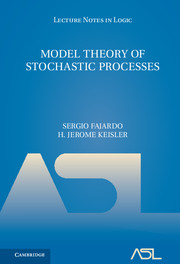Book contents
- Frontmatter
- Dedication
- Contents
- Introduction
- Chapter 1 Adapted distributions
- Chapter 2 Hyperfinite adapted spaces
- Chapter 3 Saturated spaces
- Chapter 4 Comparing stochastic processes
- Chapter 5 Definability in adapted spaces
- Chapter 6 Elementary extensions
- Chapter 7 Rich adapted spaces
- Chapter 8 Adapted neometric spaces
- Chapter 9 Enlarging saturated spaces
- References
- Index
Chapter 2 - Hyperfinite adapted spaces
Published online by Cambridge University Press: 30 March 2017
- Frontmatter
- Dedication
- Contents
- Introduction
- Chapter 1 Adapted distributions
- Chapter 2 Hyperfinite adapted spaces
- Chapter 3 Saturated spaces
- Chapter 4 Comparing stochastic processes
- Chapter 5 Definability in adapted spaces
- Chapter 6 Elementary extensions
- Chapter 7 Rich adapted spaces
- Chapter 8 Adapted neometric spaces
- Chapter 9 Enlarging saturated spaces
- References
- Index
Summary
In this chapter we study a family of adapted spaces that has been widely and successfully used in the nonstandard approach to stochastic analysis, the hyperfinite adapted spaces. The results in the monograph “An Infinitesimal Approach to Stochastic Analysis”, Keisler [1984], prompted a natural question: Why are these spaces so “rich” or “well behaved”?
In order to answer this question, we built a probability logic adequate for the study stochastic processes: adapted probability logic (see Keisler [1979], Keisler [1985], Keisler [1986a], Keisler [1986b], Hoover and Keisler [1984], Fajardo [1985a]). This is the origin of the theory we are describing in this book. We chose a somewhat different approach in Chapter 1 in order to introduce the theory in a smooth way without any need for a background in logic.
Basic nonstandard probability theory is a necessary prerequisite for most of this chapter. This theory is readily available to the interested mathematician without going through the technical literature on nonstandard analysis (see, among others, Albeverio, Fenstad, Hoegh-Krohn, and Lindstrom [1986], Cutland [1983], Fajardo [1990b], Lindstrom [1988], Stroyan and Bayod [1986] andKeisler [1988]). Nonetheless, in the following section we collect the main definitions and results needed in this book.
This seems to be an appropriate place to add a remark about the use of nonstandard analysis. It has been very hard to convince the mathematical community of the attractive characteristics of nonstandard analysis and its possible uses as a mathematical tool. This chapter, among other things, continues the task of showing with direct evidence the enormous potential that we believe nonstandard analysis has to offer to mathematics. The paper Keisler [1994] examines some of the reasons why nonstandard analysis has developed in the way we know it today and discusses the perspectives and possibilities in the years to come.
- Type
- Chapter
- Information
- Model Theory of Stochastic Processes , pp. 23 - 42Publisher: Cambridge University PressPrint publication year: 2002



